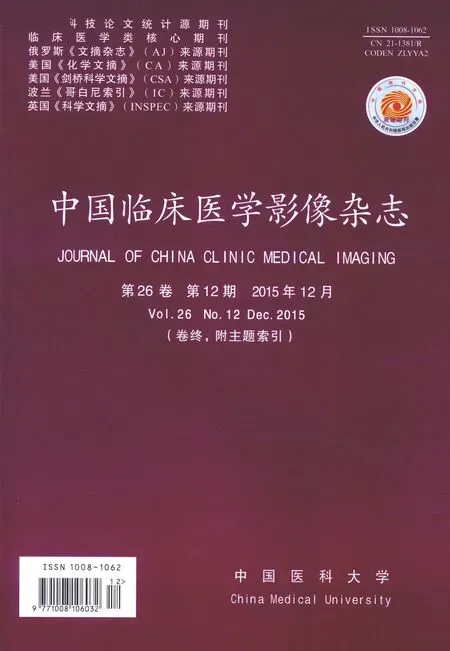煤工尘肺小叶内线影HRCT与病理的对照研究
关春爽,马大庆,崔 平,陈步东,张岩松,柳玮华
(1.首都医科大学附属北京友谊医院,北京 100050;2.北京丰台医院,北京 100071;3.国家安全监管总局职业安全卫生研究中心,北京 102300)
煤工尘肺小叶内线影HRCT与病理的对照研究
关春爽1,马大庆1,崔 平2,陈步东1,张岩松3,柳玮华1
(1.首都医科大学附属北京友谊医院,北京 100050;2.北京丰台医院,北京 100071;3.国家安全监管总局职业安全卫生研究中心,北京 102300)
目的:评估煤工尘肺患者离体肺标本在高分辨率CT(High-resolution Computed Tomography,HRCT)上的影像表现及其病理基础。方法:52例煤工尘肺标本尸检新鲜离体肺标本通过改良Heitzman法进行固定。充气状态肺标本进行HRCT冠状位及横轴位扫描。2位有经验的胸部影像医师独立读片。评估参数包括小叶内线影、微小结节、磨玻璃密度影、小叶间隔增厚、铺路石征、支气管扩张及蜂窝影。根据HRCT上感兴趣区,做组织学切片,进行影像与病理的对照研究。结果:52例肺标本,31例纳入研究范围。在横轴位CT上,仅有16.1%的病例分布在支气管血管周围,38.7%的病例分布在胸膜下。在冠状位CT上,上肺区分布的仅有16.1%。小叶内线影的伴随征象中微小结节和增厚的小叶间隔 (100%)是最常见的,其次是磨玻璃密度影(83.9%)和肺气肿(80.6%)。HRCT上小叶内线影与增厚的肺泡间隔一致,组织病理学上肺泡间隔内可见煤斑、炎症细胞、肿瘤细胞或渗出液等。结论:煤工尘肺小叶内线影可以由多种病理基础造成,小叶间隔增厚是小叶内线影最常见的伴随征象。
尘肺;体层摄影术,螺旋计算机
肺小叶内间质是位于肺泡间隔内的纤维网络,连接位于肺小叶中心的核心间质和位于小叶周边的小叶间隔及胸膜下外周间质[1]。在正常情况下,小叶内间质在高分辨率CT(High-resolution computed tomography,HRCT)上不可见,只有当间质增厚时,才能见到小叶内线影。肺小叶内线影可见于多种常见疾病[2]。但据我们所知,很少有文献[3-14]研究煤工尘肺(Coal worker's pneumoconiosis,CWP)小叶内线影在HRCT上的影像表现及与病理的对照研究。因此,本研究的目的是在HRCT上评估CWP离体肺标本小叶内线影的影像表现及明确小叶内线影的病理基础。
1 材料和方法
1.1 CWP离体肺标本资料及制作方法
收集国家安全监管总局职业安全卫生研究中心2000—2013年52例离体肺标本,均为男性,年龄48~81岁,平均(65.83±8.431)岁。所有病例均由病理诊断为CWP。纳入标准:在HRCT上有小叶内线影出现的病例。排除标准:肺结构严重扭曲及制作不良的充气肺标本,其中包括液体不能从肺内排出或明显未达到肺生理水平的标本。记录吸烟史(包年)。所有标本均为完整离体肺标本,采用改良Heiztman法固定[15]:新鲜肺在混合福尔马林溶液中固定1周,之后将标本取出,以3~5mL/s的流速通过气管向肺内充气。充气标本制成的标志为液体完全从肺内排出,肺体积基本达到生理水平。在充气状态下进行HRCT扫描,扫描完成后,离体肺标本通过气管注入福尔马林溶液,1~2 d后,用自制解剖长刀将完整肺标本按平行于气管、主支气管层面切成层厚10mm的冠状面切片,根据HRCT上的小叶内线影丰富的感兴趣区取材,石蜡包埋,之后切成层厚5μm的组织切片,进行HE染色。
1.2 设备及方法
扫描设备为GE Lightspeed Ultra 8排螺旋CT、Picker PQ 2000及GE Medical System Lightspeed XQI扫描机。充气肺标本进行冠状位及横轴位扫描。HRCT扫描参数为130 kV/140 kV,150mAs/200mAs,层厚1.25mm/2mm、层间隔10mm,骨重建算法。
1.3 影像资料的评价
2位胸部影像医师(工作年限为15年、20年)分别独立评估影像,如果出现分歧,协商读片。窗宽:1 500 HU,窗位:-600 HU。肺小叶内线影定义为在HRCT上肺小叶内纤细的线影,当多条小叶内线影存在时,表现为纤细的网影。本研究将小叶内线影的形态分为光滑型及不规则型,小叶内线影的厚度分为≤1mm和>1mm。在横轴位上小叶内线影的分布分为支气管血管束周围(肺野内2/3区)、胸膜下区(肺野外1/3区)或随机分布;在冠状位上,以气管隆突水平为界分为上肺区、下肺区,无明显的区域优势则为随机分布。小叶内线影的伴随征象包括[2]微小结节、磨玻璃密度影(Ground-glass opacity,GGO)、小叶间隔增厚、肺气肿、铺路石征、界面征、支气管扩张、蜂窝影。
1.4 病理分析
2位病理科医师(工作年限12年、18年)分别独立诊断组织切片,如果出现分歧,协商读片。
1.5 统计分析

表1 煤工尘肺小叶内线影的基本数据
2 结果
52例肺标本中,31例纳入研究,且均为男性,年龄48~80岁,平均(65.13±7.822)岁。煤尘接触史为(22.61±5.560)年 (14~34年)。患者吸烟史平均为(28.61±10.10)包年(7~48包年)。在31例肺标本中,其中纯CWP(pure CWP,pCWP)17例,CWP合并肺炎(CWP-肺炎)8例,CWP合并肺水肿(CWP-肺水肿)4例,CWP合并癌性淋巴管炎 (CWP-癌性淋巴管炎)2例。
观察者间的一致性检验:由于CWP-肺炎、CWP-癌性淋巴管炎、CWP-肺水肿均不足10例,所以本研究只检验了pCWP的HRCT表现方面观察者间一致性,为好到非常好(Kappa值=0.632~1.000,平均Kappa值=0.832)。
小叶内线影的影像表现:在31例肺标本中,所有小叶内线影厚度均≤1mm。小叶内线影以支气管血管束分布为主及以上肺区分布为主均为16.1%。小叶内线影最常见的伴随征象是微小结节及小叶间隔增厚(100.0%)(表1)。其中10例(32.3%)GGO重叠在小叶内线影形成的网影上形成铺路石征。
小叶内线影的 HRCT影像与病理对照:①pCWP,与小叶内线影相对应的病理基础为煤斑、胶原纤维及巨噬细胞聚集在肺泡间隔,并见小血管壁增厚,偶见桥纤维形成。小叶间隔增厚与小叶间隔纤维化相关,肺气肿与肺泡腔扩张及肺泡壁破坏相关,可见或不可见纤维增生。在肺泡腔或肺泡间隔内可见巨噬细胞、红细胞及单核细胞等,这与GGO相关(图1)。②CWP-肺炎,小叶内线影与单核细胞、巨噬细胞、中性粒细胞、红细胞或渗出液进入肺泡间隔相对应。这些细胞及渗出液也可以出现在肺泡腔内,这与GGO和实变相关。当细胞及浆液浸润到肺泡间隔和肺泡腔内,在HRCT上表现为铺路石征。在肺泡间隔内可见少量纤维增生,这亦与小叶内线影的形成相关(图2)。③CWP-癌性淋巴管炎,癌细胞在肺泡间隔、小血管周围、呼吸及终末支气管周围、小叶间隔内聚集,这与小叶内线影、小叶间隔增厚及小结节相关(图3)。④CWP-肺水肿,肺泡腔、肺泡间隔内可见浆液、少量炎症细胞、红细胞及少量胶原纤维,这与HRCT上小叶内线影、GGO及铺路石征相关(图4)。


图1a 男,65岁,CWP患者。冠状位HRCT,双肺上叶可见不规则型小叶内线影(箭)、微小结节(空箭)和局限性肺气肿(箭头)。方框内为取材区。 图1b 男,65岁,CWP患者。组织切片表现为肺泡间隔煤斑、肺泡腔的扩大、轻度纤维化及增厚的血管壁(HE)。图2a 男,74岁,CWP合并肺炎患者。冠状位HRCT,左肺可见光滑型小叶内线影(箭)、磨玻璃密度影(箭头),右肺上叶钙化斑块(空箭),右肺中叶结构扭曲。方框区为取材区。 图2b 男,74岁,CWP合并肺炎患者。组织切片显示肺泡间隔及肺泡腔内炎症细胞及红细胞聚集。肺泡间隔内可见轻度纤维增生(HE)。
Figure 1a. A 65-year-old man with coal worker's pneumoconiosis.High-resolution computed tomography reveals pulmonary intralobular lines(arrow),micro nodules(hollow arrow)and focal emphysema(arrowhead)in the bilateral upper-zones in the coronal view. The area indicated by the rectangular outline is the region of interest.Figure 1b. A 65-year-old man with coal worker's pneumoconiosis.Pathological findings reveal coal macules,destruction of the alveoli,slight fibrosis and thickened vascular walls(HE). Figure 2a. A 74-year-old man with coal worker's pneumoconiosis-pneumonia.High-resolution computed tomography reveals pulmonary intralobular lines(arrow),GGO(arrowhead)in the left lung and calcified plaque(hollow arrow),tortuous structures in the right middle lobe in the coronal view.The area indicated by the rectangular outline is the region of interest.Figure 2b.A 74-year-old man with coal worker's pneumoconiosis-pneumonia.Pathological findings reveal the accumulation of inflammatory cells and several red blood cells in the alveolar septa and the alveolar spaces.Slight fibrosis is evident in the alveolar septa(HE).
当充气肺标本内仍有少量福尔马林溶液残留时,肺HRCT上可出现斑片状高密度影,边缘模糊,而在病理上肺泡腔内可见液体,不可见细胞,肺泡间隔内不会出现液体。
3 讨论
HRCT上小叶内线影是一种常见的影像表现,本研究进一步发现,①小叶内线影厚度≤1mm,可以是光滑或不规则型的;②CWP小叶内线影最常见的伴随征象是微小结节和小叶间隔增厚;③CWP小叶内线影与煤斑、纤维增生、炎症、肿瘤及渗出等相关。
CWP为长期吸入直径小于5μm的煤尘颗粒,此颗粒可到达远端气腔内,停留在呼吸细支气管和肺泡内,最初的病变是由煤尘、巨噬细胞和成纤维细胞组成的混合物——煤斑,当煤斑增大,其内出现胶原,就是微小结节[16]。所以微小结节是CWP小叶内线影最常见的伴随征象之一。单纯煤尘不会引起肺内纤维性反应,故CWP纤维化范围较小,支气管扩张及蜂窝较少出现,但由于煤尘多为混合物,含有二氧化硅及其他矿物质,而游离的二氧化硅能够引起肺内纤维化反应[3]。这种纤维化反应,可能是不规则型小叶内线影数目明显高于光滑型的主要原因。不规则型与肺泡间隔纤维化及煤斑、巨噬细胞聚集相关,而光滑型与炎症细胞、肿瘤细胞、红细胞或浆液渗出等有关。小叶间隔增厚亦是小叶内线影最常见的伴随征象之一,可能与两者的病理基础相近有关[4]。肺气肿出现率较高可能与CWP或吸烟史有关。煤斑的扩大导致细支气管平滑肌萎缩,之后出现呼吸性细支气管扩张,最终导致肺气肿。吸烟是肺气肿及阻塞性肺疾病发生的重要因素,而且粉尘接触及吸烟的相互作用能够导致产生肺气肿、微小结节及间质受累[5-6]。
CWP-肺炎及CWP-肺水肿在HRCT上出现铺路石征,这与各种细胞及浆液同时浸润到肺泡间隔及肺泡腔相关。这些细胞由各种炎症细胞、红细胞等组成。Chong等[7]报道的结果与本研究相一致。CWP-癌性淋巴管炎在HRCT上表现为小叶内线影、小叶间隔增厚、支气管血管束增粗及小结节。另外,小淋巴管不仅出现在小叶间隔内,还可以出现在肺小叶内,小叶内淋巴管在肺泡及间质性肺疾病中有重要的病理生理作用[8],因此,癌性淋巴管炎的癌细胞可以出现在肺泡间隔、小叶间隔及支气管血管周围间质。
pCWP有明确的粉尘接触史,而且在HRCT上出现微小结节、不规则型小叶内线影及肺气肿,小叶内线影以下肺区分布为主等可有助于诊断[4,6]。 CWP-肺炎、CWP-肺水肿及CWP-癌性淋巴管炎均需要在HRCT上有CWP的影像表现。除了这些,CWP-肺炎有咳嗽、发热、胸痛等临床表现,HRCT上有大片状实变影及其周围出现的光滑型小叶内线影、铺路石征等可明确诊断。CWP-肺水肿的病因很多,如急性左心功能不全、肾功能不全、毒气吸入、药物过敏等,HRCT上表现为光滑型小叶内线影、小叶间隔增厚、斑片状或大片状实变影等有助于诊断[17]。CWP-癌性淋巴管炎如果有肺内恶性肿瘤的病史,在HRCT上出现结节样小叶内线影及小叶间隔增厚,而且以上肺区分布为主可以明确诊断[17]。因此,结合HRCT上的影像表现及临床表现等可以做出影像诊断。


图3a 男,62岁,CWP合并癌性淋巴管炎。冠状位HRCT,右肺上叶可见光滑型及结节样小叶内线影(箭)和小叶间隔增厚(箭头)。方框区为取材区。 图3b 男,62岁,CWP合并癌性淋巴管炎。组织切片显示癌细胞在肺泡间隔、小血管周围聚集(HE)。 图4a 男,71岁,CWP合并肺水肿。冠状位HRCT,双肺下叶可见铺路石征(箭)、局限性肺气肿(箭头),左肺上叶可见微小结节(空箭)。方框区为取材区。 图4b 男,71岁,CWP合并肺水肿。组织切片显示肺泡腔内可见浆液及炎症细胞,肺泡间隔可见少量纤维增生(HE)。
Figure 3a. A 62-year-old man with coal worker's pneumoconiosis-lymphangitis carcinomatosa.High-resolution computed tomography reveals intralobular lines(arrow),thickened interlobular septa(arrowhead)and small nodules in the right upper-zone in the coronal view.The area indicated by the rectangular outline is the region of interest.Figure 3b. A 62-year-old man with coal worker's pneumoconiosis-lymphangitis carcinomatosa.Pathological findings reveal cancer metastasis in the alveolar septa and around the vessels(HE).Figure 4a. A 71-year-old man with coal worker's pneumoconiosis-pulmonary edema.High-resolution computed tomography reveals a crazy-paving pattern(arrow)and the foci of emphysema(arrowhead)in the bilateral lower-zones in the coronal view and the micro nodules(hollow arrow)in the left upper-zone lobe.The area indicated by the rectangular outline is the region of interest. Figure 4b. A 71-year-old man with coal worker's pneumoconiosis-pulmonary edema.Pathological findings reveal a significant amount of serous fluid filling the alveolar spaces,inflammatory cells infiltrating into the alveolar spaces and slight fibrosis in the alveolar septa(HE).
本研究是回顾性分析,标本数目有限,疾病种类较少。然而,很多文献均提及小叶内线影。例如,小叶内线影在很多特发性间质性肺炎中均可以出现,病理上表现为炎症细胞浸润及小叶内间质纤维化导致肺泡间隔间质增厚[9]。慢性过敏性肺炎在HRCT上表现为广泛的小叶内线影、小叶间隔增厚、支气管扩张及蜂窝影,与肺泡细胞增生、间质纤维化、局限性间质肺炎、细支气管炎等有关。这些影像表现可以预测纤维化和生存期缩短[10]。肺移植患者中小叶内线影出现率为58.3%,而其他器官移植患者中的出现率为28%,两者有明显差异,小叶内线影的病理基础是渗出和炎症[11]。人感染H7N9禽流感早期在肺内出现局灶性GGO、小叶内线影及实变影,进展期病情进展迅速,新出现GGO及线影,肺内原有病灶融合、实变,呈多叶多段分布[12-13]。在肺癌筛查中吸烟的人群也可出现小叶内线影,而且与年龄、吸烟呈正相关,提示为特发性间质性肺炎,但是预后好于临床诊断的特发性间质性肺炎[14]。
总之,CWP肺小叶内线影纤细,以下肺区分布为主,其病理基础与纤维增生、煤斑、炎症细胞、肿瘤细胞或渗出等相关。微小结节和小叶间隔增厚是CWP小叶内线影最常见的伴随征象。
[1]Webb WR,Müller NL,Naidich DP.High resolution CT of the lung[M].3rd ed.Philadelphia:Lippincott Williams&Wilkins,2000:49-59.
[2]Hansell DM,Bankier AA,MacMahon H,et al.Fleischner Society:glossary of terms for thoracic imaging [J].Radiology,2008,246(3):697-722.
[3]Corn M,Stein F,Hammad Y,et al.Physical and chemical characteristics of “respirable”coal mine dust [J].Ann N Y Acad Sci,1972,200:17-30.
[4]Wang ZG,Ma DQ,Chen BD,et al.Morphologic manifestation of interlobular septa and pathologic basis in different stage coal worker's pneumoconiosis on high-resolution CT[J].Chin J Radiol,2006,40(7):718-721.
[5]Rom WN.Basic mechanisms leading to focal emphysema in coal workers'pneumoconiosis[J].Environ Res,1990,53(1):16-28.
[6]Akkoca Yildiz O,Eris Gulbay B,Saryal S,et al.Evaluation of the relationship between radiological abnormalities and both pulmonary function and pulmonary hypertension in coal workers' pneumoconiosis[J].Respirology,2007,12(3):420-426.
[7]Chong S,Lee KS,Chung MJ,et al.Pneumoconiosis:comparison of imaging and pathologic findings[J].Radiographics,2006,26(1): 59-77.
[8]Sozio F,Rossi A,Weber E,et al.Morphometric analysis of intralobular,interlobular and pleural lymphatics in normal human lung[J].J Anat,2012,220(4):396-404.
[9]Sumikawa H,Johkoh T,Fujimoto K,et al.Pathologically proved nonspecific interstitial pneumonia:CT pattern analysis as compared with usual interstitial pneumonia CT pattern[J].Radiology,2014,272(2):549-556.
[10]Jeong YJ,Lee KS,Chung MP,et al.Chronic hypersensitivity pneumonitis and pulmonary sarcoidosis:differentiation from usual interstitial pneumonia using high-resolution computed tomography [J].Semin Ultrasound CT MR,2014,35(1):47-58.
[11]Bertolotti A,Defranchi S,Vigliano C,et al.Surgical lung biopsy in transplant patients with diffuse lung disease:how much worse when the lung is the graft?[J].Ann Thorac Surg,2013,96(1):279-285.
[12]Wang Q,Zhang Z,Shi Y,et al.Emerging H7N9 influenza A (novel reassortant avian-origin)pneumonia:radiologic findings[J].Radiology,2013,268(3):882-889.
[13]Dai J,Zhou X,Dong D,et al.Human infection with a novel avian-origin influenza A(H7N9)virus:serial chest radiographic and CT findings[J].Chin Med J(Engl),2014,127(12):2206-2211.
[14]Jin GY,Lynch D,Chawla A,et al.Interstitial lung abnormalities in a CT lung cancer screening population:prevalence and progression rate[J].Radiology,2013,268(2):563-571.
[15]Heitzman ER.The lung:radiologic-pathologic correlations[M].2nd ed.St Louis:Mosby,1984:4-12.
[16]Churg A,Green FH.Pathology of occupational lung disease[M].New York-Tokyo:Igaku-Shoin,1988:213-234.
[17]McLoud TC,Boiselle PM.Thoracic Radiology:The Requisites [M].2nd ed.St Louis:Mosby,2010:145-301.
A comparative study of HRCT findings and pathological basis of intralobular lines in coal workers'pneumoconiosis
GUAN Chun-shuang1,MA Da-qing1,CUI Ping2,CHEN Bu-dong1,ZHANG Yan-song3,LIU Wei-hua1
(1.Beijing Friendship Hospital,Capital Medical University,Beijing 100050,China; 2.Beijing Fengtai Hospital,Beijing 100071,China; 3.National Research Center for Occupational Safety and Health,Beijing 102300,China)
Objective:To evaluate the imaging features of high-resolution CT(HRCT)and pathological basis in patients with coal workers'pneumoconiosis(CWP).Methods:Fifty-two fresh lungs from patients with CWP were fixed and inflated by the Heitzman method.The inflated specimens underwent HRCT coronal and transverse planes scanning.Two experienced chest radiologists independently made the diagnosis results.The evaluation parameters included intralobular lines,micronodules,ground-glass opacity(GGO),thickened intralobular septa,crazy-paving pattern,bronchiectasis,and honeycombing.A comparative study of image and pathology was performed on the tissue sections according to the HRCT region of interest.Results:Of the 52 specimens,21 were excluded because of structure distortion,and 31 were enrolled in this study.In the transverse projection,only 16.1%of the specimens exhibited peribronchovascular predominance,and 38.7%exhibited subpleural predominance.In the coronal view,the incidence of distribution in the upper-zone was only 16.1%.Among the accompanying signs of intralobular lines,micronodules and thickened interlobular septa were the most common observations(100%),followed by GGO (83.9%)and emphysema(80.6%).The intralobular lines on HRCT corresponded to thickened alveolar septa that were associated with coal macules,fibrosis,inflammation,tumors,and serous fluid based on pathology.Conclusion:The intralobular lines of CWP on HRCT correlate with a variety of pathological backgrounds.The thickened interlobular septa are the most frequent accompanying sign.
Pneumoconiosis;Tomography,spiral computed
R135.2;R814.42
A
1008-1062(2015)12-0873-04
2015-05-11;眼
2015-06-07
关春爽(1980-),女,河北唐山人,主治医师。
马大庆,首都医科大学附属北京友谊医院,100050。

